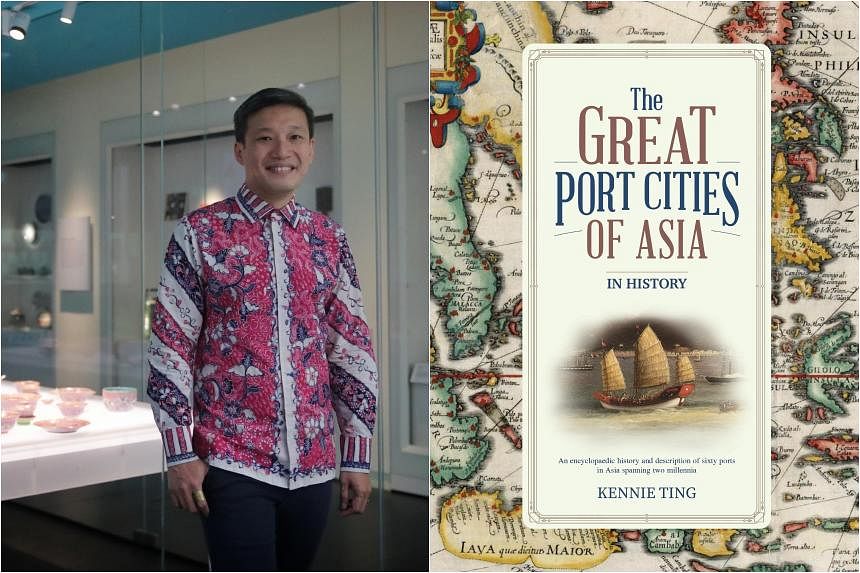The Great Port Cities Of Asia: In History
By Kennie Ting
Non-fiction/Talisman/Hardcover/364 pages/$36.81/Amazon.sg (amzn.to/3Ux5Ji5)
4 stars
There are no boring histories, only boring storytellers.
And one certainly cannot accuse Kennie Ting, outgoing director of the Asian Civilisations Museum (ACM), of being boring. In his stint at the ACM, he has shown a knack for translating dry academic research in accessible and, I dare say, even fun ways for the layman.
His books have followed in similar fashion, cherry-picking historical anecdotes and reframing them in a readable fashion that makes history come alive for both the layman and the engaged amateur.
His latest book, The Great Port Cities Of Asia: In History, is a handsomely produced hardcover, jam-packed with information and illustrations. It is a whistle-stop tour through 60 port cities which have been critical nodes of trade, political, cultural and social exchanges over two millennia of human history.
This ambitious span means each port city chapter is, perforce, brief. Some hardcore historians might sniff at this brevity. But short does not mean shallow.
Ting has obviously done his research, and excels in communicating context and meaning in a way that is immediately relatable for a modern reader.
In summarising the cultural and social impact of the Melaka sultanate in the 16th century, which “defined what it meant to be Malay” and became “a paragon of style and fashion”, he characterises the city as the “Paris of Nusantara”. It is an evocative description that instantly sums up the glamour and soft power of Melaka then.
Other contemporary turns of phrase help elucidate long-dead characters and revive forgotten places.
The fourth governor-general of the Vereenigde Oostindische Compagnie (better known as the Dutch East India Company), Jan Pieterszoon Coen, is “a genocidal maniac”, while the elaborately ornamented bay windows of traditional coral houses in Jeddah are “a form of architectural bling” used by owners to flaunt their wealth.
This conversational tone helps convey masses of obscure historical information. Unless one is an academic, it is hard to access the recent research which has decentred Asian and South-east Asian histories from the deeply colonised narratives that have thus far dominated historical discourses.
One of the pleasures of reading this book is this recentring of narratives, using the idea of port cities to reorganise stories in ways that highlight the vibrancy, wealth and globalised nature of Asian civilisations in the pre-colonial era.
Conventional history accounts tend, as Ting notes in his introduction, to present these civilisations as monolithic, geographically circumscribed powers. But their borders were far more porous, and looking at histories through the network model presented by port cities offers a new and illuminating way of parsing human interactions through the ages.
This view also allows for some startling reminders of which empires were contemporaneous with one another, and the sort of trade and diplomatic ties they would have built. For example, in the chapter on Palembang, Ting points out that Srivijaya in the eighth century was the third global power, after the Abbasid Caliphate and Tang China.
The traditional narratives of Western colonial powers sweeping irresistibly across Africa and Asia are amended with some necessary correctives. The chapter on Mombasa notes that it took some 90 years for the Portuguese to subdue the African city, while Aceh, under the rulership of four queens no less, resisted European powers for 200 years after first contact in the 17th century.
If there is a quibble with this book, it is that the narrative attempts to cover too much ground in its sprawling embrace of so many cities. The chapters which cover some cities in the last third of the book, such as Mumbai and Dubai, focus overly much on the architecture to the detriment of the historical elements.
But this is a minor quibble, and the book is best appreciated not in one long reading, but in tiny dips over a longer span. Each chapter is like a historic postcard delivering a snapshot of cultures and civilisations long gone, but still resonating in peculiar, small ways in their respective port cities.
If you like this, read: The Romance Of The Grand Tour by Kennie Ting (Talisman, 2015, National Library Board, 925.9 TIN-[TRA], go to str.sg/uiKr). Twelve South-east Asian port cities are featured in this earlier iteration, which delves into these destinations, glittering attractions strung across Asia that held the promise of exotica for Western travellers in the early years of the 20th century.


